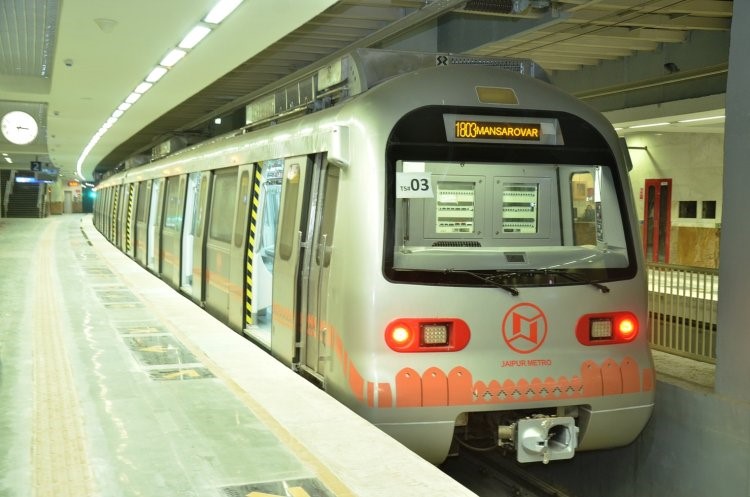Jaipur, famously known as the “Pink City of India,” is a city steeped in history, heritage, and royal charm. While Jaipur’s forts, palaces, and bazaars attract millions of tourists every year, the city’s growing population and traffic congestion also call for a modern urban transportation system. To address this, the Jaipur Metro was launched as one of India’s latest metro rail systems, blending efficiency with convenience for daily commuters and tourists alike.
The Jaipur Metro is not just a mode of transport but also a crucial connector between heritage sites, bustling markets, and growing residential as well as commercial hubs. For tourists, it provides easy connectivity to some of the most visited landmarks like Hawa Mahal, City Palace, and Jal Mahal. For residents, it makes daily commutes faster and more reliable.
This in-depth blog will systematically cover all aspects of Jaipur Metro—route maps, station list, timings, tourist connectivity, ticketing, and even future plans like Jaipur Metro Phase 2. Additionally, we will answer common questions about fares, station details, and travel tips to make your metro journey in Jaipur hassle-free.
Also Read:- Delhi Cantt: Metro Station List | Nearest Metro | Base Hospital
In Which Year Did Jaipur Metro Start?
The Jaipur Metro officially began operations on June 3, 2015. It was inaugurated by then-Chief Minister Vasundhara Raje, making Jaipur the sixth Indian city to have a metro system after Delhi, Bengaluru, Kolkata, Chennai, and Mumbai.
What is the Route of Jaipur Metro?

Currently, the Jaipur Metro operates on the Pink Line (Phase 1), covering important parts of the city.
- Phase 1-A: Mansarovar to Chandpole (9.63 km)
- Phase 1-B: Chandpole to Badi Chaupar (2.34 km, underground section)
The operational corridor runs through key commercial areas, government offices, and cultural landmarks.
Also Read:- Bengaluru’s Yellow Line Namma Metro Set to Boost Affordable Real Estate Markets
Jaipur Metro Route Map

The Jaipur Metro Route Map is designed to connect major areas of the city while ensuring easy access for tourists.
Jaipur Metro Route Map (Phase 1 – Pink Line):
- Mansarovar
- New Aatish Market
- Vivek Vihar
- Shyam Nagar
- Ram Nagar
- Civil Lines
- Railway Station
- Sindhi Camp
- Chandpole
- Chhoti Chaupar
- Badi Chaupar
This route is especially useful for tourists as it connects Railway Station, Sindhi Camp (bus stand), and heritage attractions like Hawa Mahal and City Palace.
Also Read:- Lucknow Metro Map: Route Map | Images | Fare | News
Jaipur Metro Phase 2: What is Planned?
Jaipur Metro Phase 2 aims to extend the network to cover newer residential areas and the city’s outskirts.
- Phase 2 will connect Ambabari to Sitapura Industrial Area, covering around 23 km with approximately 20 stations.
- This phase will link key employment hubs, educational institutions, and Jaipur International Airport.
- Once operational, Phase 2 will make Jaipur Metro an even stronger alternative to road transport.
How Many Metro Stations Are There in Jaipur?
Currently, Jaipur Metro has 11 operational stations across the Pink Line (Phase 1). With Phase 2 in progress, the number is expected to increase significantly.
Also Read:- Green Line Metro: Complete Route, Station List & Map
Which is the Biggest Station in Jaipur Metro?

Chandpole Station is one of the largest stations on the Jaipur Metro network. It acts as a crucial interchange between commercial areas and tourist destinations.
Jaipur Metro Near Tourist Places: How Convenient is It?
One of the highlights of Jaipur Metro is its proximity to major tourist attractions.
- Jaipur Metro to Hawa Mahal: Nearest station is Badi Chaupar, just 300 meters away.
- Nearest Metro Station to Jal Mahal: Jal Mahal does not have a direct metro stop, but Badi Chaupar is the closest station. From there, local autos and cabs are available.
- City Palace & Jantar Mantar: Both are also easily accessible from Badi Chaupar Station.
- Albert Hall Museum: Closest metro station is Sindhi Camp, from where you can take a cab or rickshaw.
Jaipur Metro to Airport: Is There Direct Connectivity?
Currently, Jaipur Metro does not connect directly to Jaipur International Airport. The nearest operational station is Ram Nagar, which is around 11 km away. However, Jaipur Metro Phase 2 is expected to cover the airport, making travel much easier for passengers.
Jaipur Junction to Metro Station: How to Reach?
Jaipur Railway Junction is connected to the metro through Railway Station Metro Stop. It is just outside the main entrance, making train-to-metro connectivity seamless for passengers.
Jaipur Metro Timing: When Does It Start in the Morning?
- On Weekdays: Jaipur Metro starts at 6:20 AM and runs until 9:49 PM.
- On Sundays and Holidays: The metro usually starts a little later at 7:00 AM.
Jaipur Metro Time Table
Trains run every 10–15 minutes during peak hours and every 15–20 minutes during non-peak hours. The Jaipur Metro time table is designed to accommodate both office commuters and tourists.
How Much Does a Jaipur Metro Ticket Cost?

- Minimum fare: ₹6
- Maximum fare: ₹23 (depending on the distance traveled)
This makes Jaipur Metro one of the most affordable metro services in India.
Jaipur Metro App: Why Should You Use It?
The Jaipur Metro App helps passengers with:
- Checking Jaipur Metro Route Map
- Viewing real-time Jaipur Metro Time Table
- Ticket booking and smart card recharge options
- Updates about Jaipur Metro Phase 2 developments
Jaipur Metro Smart Card: How to Get and Recharge It?

How to Make Jaipur Metro Smart Card?
You can purchase a smart card at any metro station ticket counter by providing a valid ID proof. A refundable security deposit is required.
How to Recharge Jaipur Metro Card Online?
Recharging can be done via the Jaipur Metro App or directly at station counters. Online recharges save time and help avoid queues.
Jaipur Metro Ticket Booking Online: How Does It Work?
Passengers can book metro tickets using:
- The official Jaipur Metro App
- QR code-based ticketing machines at stations
- Digital payment platforms integrated with the metro system
Jaipur Metro: Government or Private?
The Jaipur Metro is a government-owned and operated system, run by the Jaipur Metro Rail Corporation Limited (JMRC), a state government body.
Why Jaipur Metro Failed to Expand Quickly?
Although Jaipur Metro started with much anticipation, its expansion has been slower compared to other cities due to:
- High construction costs for underground stretches
- Limited ridership in early years
- Bureaucratic delays in land acquisition and approvals
With Phase 2 now under planning, the network is expected to grow in the coming years.
Conclusion
The Jaipur Metro is more than just a public transport system—it is a lifeline that connects the city’s rich past with its rapidly growing modern future. From making daily commutes easier to helping tourists access attractions like Hawa Mahal and Jal Mahal, the metro has proven to be a convenient and affordable solution for the Pink City. While expansion delays slowed its progress, upcoming projects like Jaipur Metro Phase 2 promise to bridge more areas, including Jaipur Airport.
At Housiey, we believe real estate thrives where strong infrastructure exists, and Jaipur Metro is a perfect example of how urban connectivity boosts lifestyle and investment.
If you are fascinated by metro developments, don’t miss our detailed blog on Namma Metro Yellow Line, which highlights Bengaluru’s rapidly growing metro expansion.
FAQs
Jaipur, famously known as the “Pink City of India,” is a city steeped in history, heritage, and royal charm. While Jaipur’s forts, palaces, and bazaars attract millions of tourists every year, the city’s growing population and traffic congestion also call for a modern urban transportation system. To address this, the Jaipur Metro was launched as one of India’s latest metro rail systems, blending efficiency with convenience for daily commuters and tourists alike.
The Jaipur Metro is not just a mode of transport but also a crucial connector between heritage sites, bustling markets, and growing residential as well as commercial hubs. For tourists, it provides easy connectivity to some of the most visited landmarks like Hawa Mahal, City Palace, and Jal Mahal. For residents, it makes daily commutes faster and more reliable.
This in-depth blog will systematically cover all aspects of Jaipur Metro—route maps, station list, timings, tourist connectivity, ticketing, and even future plans like Jaipur Metro Phase 2. Additionally, we will answer common questions about fares, station details, and travel tips to make your metro journey in Jaipur hassle-free.
Also Read:- Delhi Cantt: Metro Station List | Nearest Metro | Base Hospital
In Which Year Did Jaipur Metro Start?
The Jaipur Metro officially began operations on June 3, 2015. It was inaugurated by then-Chief Minister Vasundhara Raje, making Jaipur the sixth Indian city to have a metro system after Delhi, Bengaluru, Kolkata, Chennai, and Mumbai.
What is the Route of Jaipur Metro?

Currently, the Jaipur Metro operates on the Pink Line (Phase 1), covering important parts of the city.
- Phase 1-A: Mansarovar to Chandpole (9.63 km)
- Phase 1-B: Chandpole to Badi Chaupar (2.34 km, underground section)
The operational corridor runs through key commercial areas, government offices, and cultural landmarks.
Also Read:- Bengaluru’s Yellow Line Namma Metro Set to Boost Affordable Real Estate Markets
Jaipur Metro Route Map

The Jaipur Metro Route Map is designed to connect major areas of the city while ensuring easy access for tourists.
Jaipur Metro Route Map (Phase 1 – Pink Line):
- Mansarovar
- New Aatish Market
- Vivek Vihar
- Shyam Nagar
- Ram Nagar
- Civil Lines
- Railway Station
- Sindhi Camp
- Chandpole
- Chhoti Chaupar
- Badi Chaupar
This route is especially useful for tourists as it connects Railway Station, Sindhi Camp (bus stand), and heritage attractions like Hawa Mahal and City Palace.
Also Read:- Lucknow Metro Map: Route Map | Images | Fare | News
Jaipur Metro Phase 2: What is Planned?
Jaipur Metro Phase 2 aims to extend the network to cover newer residential areas and the city’s outskirts.
- Phase 2 will connect Ambabari to Sitapura Industrial Area, covering around 23 km with approximately 20 stations.
- This phase will link key employment hubs, educational institutions, and Jaipur International Airport.
- Once operational, Phase 2 will make Jaipur Metro an even stronger alternative to road transport.
How Many Metro Stations Are There in Jaipur?
Currently, Jaipur Metro has 11 operational stations across the Pink Line (Phase 1). With Phase 2 in progress, the number is expected to increase significantly.
Also Read:- Green Line Metro: Complete Route, Station List & Map
Which is the Biggest Station in Jaipur Metro?

Chandpole Station is one of the largest stations on the Jaipur Metro network. It acts as a crucial interchange between commercial areas and tourist destinations.
Jaipur Metro Near Tourist Places: How Convenient is It?
One of the highlights of Jaipur Metro is its proximity to major tourist attractions.
- Jaipur Metro to Hawa Mahal: Nearest station is Badi Chaupar, just 300 meters away.
- Nearest Metro Station to Jal Mahal: Jal Mahal does not have a direct metro stop, but Badi Chaupar is the closest station. From there, local autos and cabs are available.
- City Palace & Jantar Mantar: Both are also easily accessible from Badi Chaupar Station.
- Albert Hall Museum: Closest metro station is Sindhi Camp, from where you can take a cab or rickshaw.
Jaipur Metro to Airport: Is There Direct Connectivity?
Currently, Jaipur Metro does not connect directly to Jaipur International Airport. The nearest operational station is Ram Nagar, which is around 11 km away. However, Jaipur Metro Phase 2 is expected to cover the airport, making travel much easier for passengers.
Jaipur Junction to Metro Station: How to Reach?
Jaipur Railway Junction is connected to the metro through Railway Station Metro Stop. It is just outside the main entrance, making train-to-metro connectivity seamless for passengers.
Jaipur Metro Timing: When Does It Start in the Morning?
- On Weekdays: Jaipur Metro starts at 6:20 AM and runs until 9:49 PM.
- On Sundays and Holidays: The metro usually starts a little later at 7:00 AM.
Jaipur Metro Time Table
Trains run every 10–15 minutes during peak hours and every 15–20 minutes during non-peak hours. The Jaipur Metro time table is designed to accommodate both office commuters and tourists.
How Much Does a Jaipur Metro Ticket Cost?

- Minimum fare: ₹6
- Maximum fare: ₹23 (depending on the distance traveled)
This makes Jaipur Metro one of the most affordable metro services in India.
Jaipur Metro App: Why Should You Use It?
The Jaipur Metro App helps passengers with:
- Checking Jaipur Metro Route Map
- Viewing real-time Jaipur Metro Time Table
- Ticket booking and smart card recharge options
- Updates about Jaipur Metro Phase 2 developments
Jaipur Metro Smart Card: How to Get and Recharge It?

How to Make Jaipur Metro Smart Card?
You can purchase a smart card at any metro station ticket counter by providing a valid ID proof. A refundable security deposit is required.
How to Recharge Jaipur Metro Card Online?
Recharging can be done via the Jaipur Metro App or directly at station counters. Online recharges save time and help avoid queues.
Jaipur Metro Ticket Booking Online: How Does It Work?
Passengers can book metro tickets using:
- The official Jaipur Metro App
- QR code-based ticketing machines at stations
- Digital payment platforms integrated with the metro system
Jaipur Metro: Government or Private?
The Jaipur Metro is a government-owned and operated system, run by the Jaipur Metro Rail Corporation Limited (JMRC), a state government body.
Why Jaipur Metro Failed to Expand Quickly?
Although Jaipur Metro started with much anticipation, its expansion has been slower compared to other cities due to:
- High construction costs for underground stretches
- Limited ridership in early years
- Bureaucratic delays in land acquisition and approvals
With Phase 2 now under planning, the network is expected to grow in the coming years.
Conclusion
The Jaipur Metro is more than just a public transport system—it is a lifeline that connects the city’s rich past with its rapidly growing modern future. From making daily commutes easier to helping tourists access attractions like Hawa Mahal and Jal Mahal, the metro has proven to be a convenient and affordable solution for the Pink City. While expansion delays slowed its progress, upcoming projects like Jaipur Metro Phase 2 promise to bridge more areas, including Jaipur Airport.
At Housiey, we believe real estate thrives where strong infrastructure exists, and Jaipur Metro is a perfect example of how urban connectivity boosts lifestyle and investment.
If you are fascinated by metro developments, don’t miss our detailed blog on Namma Metro Yellow Line, which highlights Bengaluru’s rapidly growing metro expansion.
FAQs












